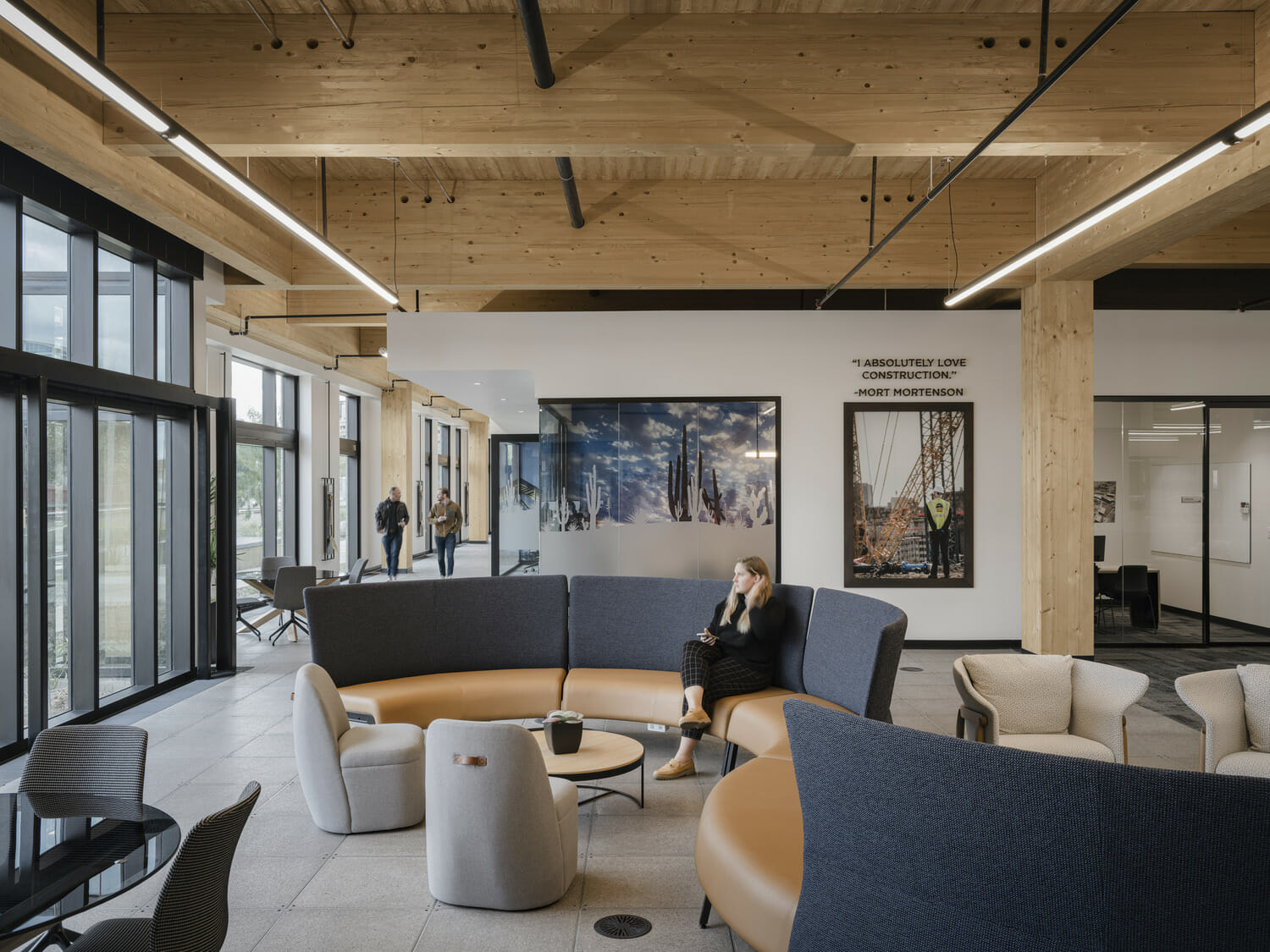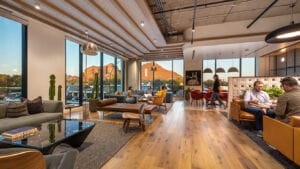In the quest to enhance employee well-being through office design, we’ve gathered insights from founders, CEOs, and other business leaders. From revamping office spaces to foster productivity to introducing interactive elements that encourage collaboration, explore the thirteen thoughtful changes these professionals have implemented in their work environments. Here’s how to enhance employee well-being through office design:
LEARN MORE: 20 coolest offices in Arizona for 2023
- Revamped Office Space Enhances Productivity
- Tailored Design Inspires Team
- Technology Integration Fosters Team Collaboration
- Zen Corner Offers Tranquil Employee Retreat
- Quiet Corners Decrease Stress, Boost Creativity
- Homey Office Elements Improve Team Comfort
- Pet-Friendly Policy Elevates Morale
- Employee-Selected Art Instills Pride
- Biophilic Design Reduces Workplace Stress
- Color-Coded Zones Align with Work Activities
- Ambient Music Creates Relaxed Atmosphere
- Customizable Workstations Personalize Space
- Interactive Elements Encourage Collaboration
Revamped Office Space Enhances Productivity
Office design holds quite a lot of influence on employee well-being. It’s more than just aesthetics—it impacts productivity, creativity, and stress levels.
So, we revamped our office space. We brought in ergonomic furniture for comfort, added natural light to boost mood, and created both open areas for collaboration and quiet spots for focused work. Plus, we introduced plants for cleaner air and a calmer vibe.
These changes made a real difference. Our team is more productive and happier, with less stress and fewer physical complaints. In the high-stakes world of construction insurance, a supportive workspace isn’t a luxury—it’s a necessity.
Michael Benoit, Founder, Contractor Bond
Tailored Design Inspires Team
Thoughtful office design profoundly enhances employee well-being, especially in our dynamic field. We tailored our office to meet our team’s unique needs, emphasizing efficiency and morale while reflecting the essence of deer hunting.
Our office transformation creates a space that’s more than desks; it’s a hub for training and preparation, vital for our hunting guides. We integrated outdoor elements like natural light, greenery, and hunting-inspired materials to keep our team connected to their passion.
These changes have a significant impact, inspiring and motivating our team. It fosters creativity, strategy development, and a strong team spirit, enhancing efficiency and deepening our connection to our mission.
John Vanderlaan, Founder, Deer Hunting Guide
Technology Integration Fosters Team Collaboration
In my working career, I’ve seen how technology can improve office communication. Beyond aesthetics, creative workplace design increasingly combines cutting-edge technology to boost teamwork. Interactive screens become dynamic central areas in modern workplaces, breaking down barriers to cooperation.
These high-tech canvases display ideas in real time and promote spontaneous brainstorming, creating a creative synergy beyond physical borders. Video conferencing has saved remote cooperation by linking colleagues worldwide. The immersive experience these tools provide makes working with team members in different time zones easier. Virtual face-to-face contacts help separated teams bond. Smart communication technologies expedite our operations and simplify idea sharing. These applications go beyond typical chat platforms by automatically adapting to team members’ pace and preferences.
As a result, communication tension decreases, and we focus on the content rather than the channel. After my experiences, I’ve realized how technology integrated into office architecture fosters collaboration. It turns places into dynamic hubs where ideas flow freely, breaking down barriers and encouraging innovation. Advanced technology isn’t just a trend; it’s a powerful connector that transforms teamwork and boosts employee potential.
David Boyd, Co-Founder, Frequent Flyer Credit Cards
Zen Corner Offers Tranquil Employee Retreat
We created a Zen Corner in our office, dedicated to relaxation and quiet reflection. This space, equipped with comfortable seating, soft lighting, and calming decor, offers employees a place to decompress and recharge.
The Zen Corner has become a popular retreat for employees seeking tranquility amidst their busy schedules, essential for mental well-being. This space has not only provided a peaceful escape but also contributed to a more balanced and mindful work environment, where employees feel supported in managing stress and prioritizing mental health.
Stephan Baldwin, Founder, Assisted Living Center
Quiet Corners Decrease Stress, Boost Creativity
In my experience, an unconventional but impactful change in office design was the incorporation of designated quiet corners. These were small, secluded spaces adorned with comfortable seating and soothing decor. The offbeat intention was to provide employees with a retreat for moments of mindfulness and relaxation amidst their busy workdays. The unexpected positive impact was a notable decrease in stress levels and an increase in focus and creativity.
By acknowledging the importance of quiet and reflective spaces, the thoughtful office design not only enhanced employee well-being but also fostered a more balanced and tranquil work environment.
Ben Richardson, Director, Acuity Training
Homey Office Elements Improve Team Comfort
Since working hybridly is a major theme for most businesses (us included), I discovered that having some familiar elements of home is actually really important for the productivity and comfort of my team.
An office space that feels like home can contribute to a positive company culture, as it sends a message that the organization values the well-being and happiness of its employees, fostering a sense of community. I also find that a well-designed and cozy office space can help combat burnout and fatigue.
By adding features such as comfortable furniture, adequate lighting, and calming colors, you can contribute to a less stressful work environment. Making an office space feel more like home is important for employees, as it positively influences their well-being, productivity, and overall job satisfaction. It contributes to a positive work culture and can be a key factor in attracting and retaining talented individuals within the organization.
Meghan Freed, Managing Co-Partner, Freed Marcroft
Pet-Friendly Policy Elevates Morale
We introduced a bring-your-pet-to-work policy along with redesigning our office to include pet-friendly spaces. This initiative has brought a lot of joy and stress relief to the team. Having pets around has created a more relaxed and homely atmosphere, which has boosted morale and fostered a sense of companionship among employees.
The presence of pets has also encouraged more social interactions and breaks, leading to a more balanced and enjoyable work environment.
John Hughes, CEO, ContractorNerd
Employee-Selected Art Instills Pride
Our office now features art installations and sculptures, selected by the employees themselves. This initiative has not only beautified our workspace but also given employees a sense of ownership and pride in their environment.
The presence of art has stimulated creativity and provided inspiration, contributing to a more stimulating and enjoyable work environment. This approach has been key in creating a workspace that reflects the creativity and diversity of our team.
Thaddeus Wendt, Partner and CEO, Feller Wendt, LLC
Biophilic Design Reduces Workplace Stress
It has allowed teams to work in an environment that is not adding to stress levels. If anything, biophilic design and natural lighting are designed for de-stressing, not to make a working environment worse!
Tracey Beveridge, HR Director, Personnel Checks
Color-Coded Zones Align with Work Activities
We introduced a color-coded zoning system in our office, with different colors signifying different types of work areas—blue for calm, focused work; red for dynamic, collaborative tasks; and green for relaxation and informal meetings. This color-coding has helped in creating spaces that are psychologically aligned with the activities they are meant for, enhancing productivity and reducing stress.
Employees appreciate the clear visual cues that help them quickly find the best space for their current task, and they have reported feeling more organized and focused. Additionally, this system has added a vibrant and lively feel to our office, making it a more engaging and pleasant place to work.
Roman Zrazhevskiy, Founder and CEO, MIRA Safety
Ambient Music Creates Relaxed Atmosphere
We’ve implemented a sound system that plays soft, ambient music in common areas, creating a more relaxed atmosphere. Employees have noted that this background music helps reduce stress and improves concentration, particularly in areas where silence can be overwhelming.
This subtle addition has enhanced the overall ambiance of our workspace, making it more pleasant and conducive to productivity. The music has also been effective in creating a consistent and calming background, helping to mask intermittent office noises.
J. Tucker Merrigan, Managing Partner, Sweeney Merrigan
Customizable Workstations Personalize Space
In my experience, an often-overlooked aspect of thoughtful office design that significantly boosted employee well-being was the introduction of customizable workstations. Instead of a one-size-fits-all approach, we allowed employees to personalize their desks with plants, artwork, and adjustable furniture.
This offbeat initiative empowered individuals to create a workspace that reflected their personality and preferences. The unexpected positive outcome was a notable reduction in stress and an increase in job satisfaction. Employees found comfort in a space that felt uniquely theirs, fostering a sense of ownership and well-being that transcended the typical perks associated with office design.
Ashwin Ramesh, CEO, Synup
Interactive Elements Encourage Collaboration
We added interactive elements like whiteboards and brainstorming walls throughout the office. These tools encourage spontaneous collaboration and idea-sharing, creating a more dynamic and interactive work environment. Employees enjoy the flexibility to express ideas and collaborate in different areas of the office, fostering creativity and a sense of community.
This has contributed to higher job satisfaction and a more engaging work atmosphere, as employees feel more connected and involved in collaborative processes.
Ryan Zomorodi, COO and Co-Founder, Real Estate Skills




